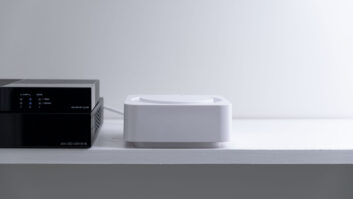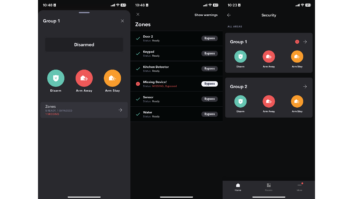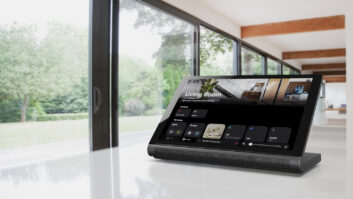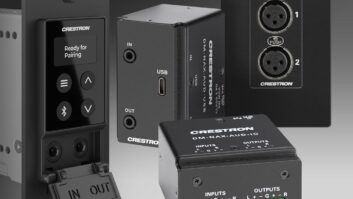Starting today, you’re going to be hearing the word Pyng a lot and you’re going to want to pay attention because Pyng is a game-changer not only for Crestron but potentially for the industry as a whole.
I’ve had a chance to live with a Pyng system in my home for the past couple of weeks in preparation for an upcoming Residential Systems review and I have to say that it definitely lives up to the hype. Pyng works, and it works simply and it works well.
Far from the near Master’s degree and days required to program a typical Crestron automation system using the not-at-all simple SIMPL Windows programming language, app-based Pyng removes all the heavy lifting and brings programming powerful automation to a near DIY level. Oh, yeah, and you can completely ditch your programming laptop for Pyng systems (although there will always be a place for the uber-customization that Crestron’s programming tools enable).

Pyng Hub
The heart of Pyng is the Hub, a small, white box a bit bigger than an AppleTV. Connect the Hub to your network via Ethernet cable and download the free Pyng app onto an iPad and you’re mostly done. (A slimmed down iPhone version will be available for control but not set-up, and an Android version is coming soon.) Pyng relies heavily on Crestron’s proprietary wireless mesh-network technology, infiNET EX, and controls infiNET EX lighting, shades, thermostats, motion sensors, keypads, and door locks. It can also control a security panel with an Ethernet-to-RS-232 box. This full range of options means Pyng will handle the vast majority of typical automation requirements straight out of the gate. The Pyng Hub also features a Cresnet port which will be used to add additional devices in the future.

Pyng Build House
Set-up is done in real-time with updates instantly added to the system. This enables immediate checking of any change literally the second you make it. After “building your house” by adding and naming rooms throughout the project, you add devices by putting the app into “pairing” mode and then simple walking around the home doing a tap-tap-tap-hold button press on the devices you want to add. Install a new dimmer, add it to the project, name it, and start controlling it instantly. Pyng is so fast I was able to integrate newly installed roller shades literally before the installer was able to climb down from the ladder! Then it was a matter of setting scenes and time-of-day scheduled events literally as quickly as I could think of them.

Pyng Scheduler
With a 4-button Crestron Cameo dimmer/keypad in my dining room, I created buttons for raising/dimming my dining chandelier, and toggling the upper and lower shades all in about two minutes. I didn’t like the layout of a keypad by my back door, so I just whipped out the iPad and changed the button configuration and updated the functions without missing a beat. There’s no compiling or downloading or anything. It’s just…done. Labeling the buttons in the Pyng program also creates an engraving file that can be emailed to the dealer for ordering the engraved buttons.

Pyng Lighting Scenes
The Pyng app is so simply and intuitively laid out it is actually designed for a homeowner to go in and create, configure, and edit lighting, shade, thermostat, and timed events without involving the dealer. This means no longer having to go back to a project because the homeowner wishes the “Night” mode included an additional light or the dim level was 62% instead of 67% or the shade went up at five minutes before sunset and not after. Programming is so fast and easy I added an “Away” scheduled event to my lighting system before my plane flight to Denver as it popped into my head while walking from the shower back to my bedroom. I just grabbed the iPad, opened the Pyng app, tapped on scheduled events, picked 30 minutes before sunrise, and then added the lights I wanted to control and set their levels.
Homeowners can use the app to access Pyng remotely to check on their home or make adjustments. Dealers can also access a client’s Pyng system remotely via the app to make any changes or pull diagnostic logs. The Hub automatically backs up settings to the my Crestron cloud service and the dealer can set a Golden Project point that can be restored in case a homeowner gets a little carried away with making changes.
Pyng can also integrate into traditional, “big” Crestron jobs, with the dealer being able to “drag” the Pyng app right onto touchscreens of a project. Thus when any changes are made to the project either by the homeowner or dealer in Pyng, they are immediately updated to the rest of the system without any additional programming or downloading.
Pyng will bring the price of smart, reliable, luxury automation way downstream and make for happier customers, less time on jobs, and fewer follow-up truck rolls. If you’re at CEDIA Expo this week, definitely stop by Crestron’s booth (#150) for a demo and stay tuned for my full review.
John Sciacca is principal of Custom Theater and Audio in Myrtle Beach, SC.







